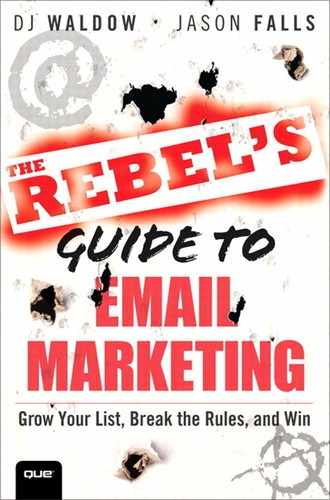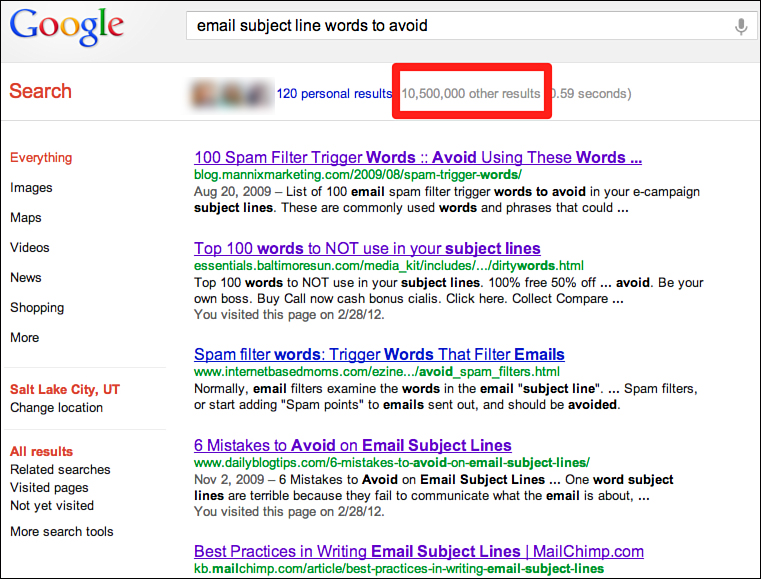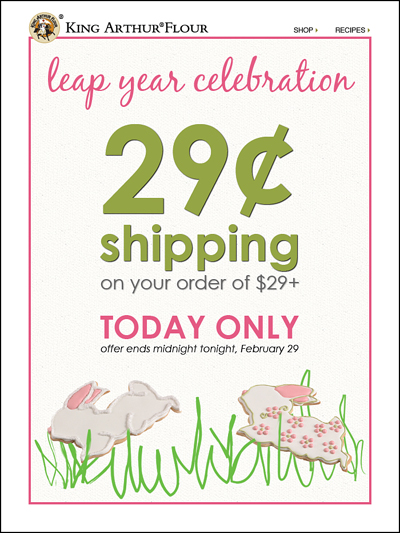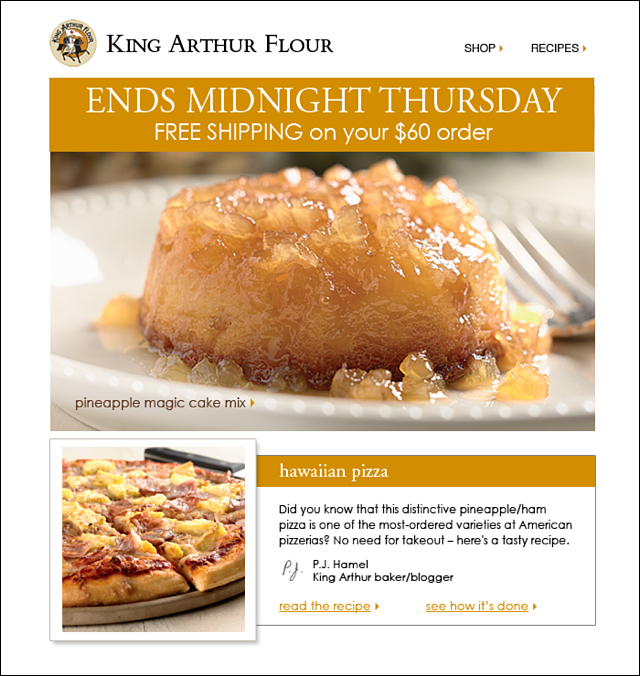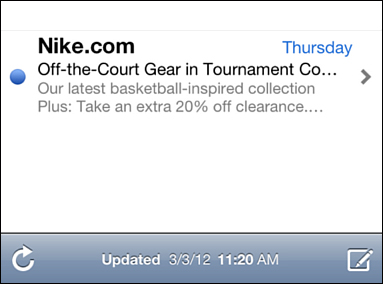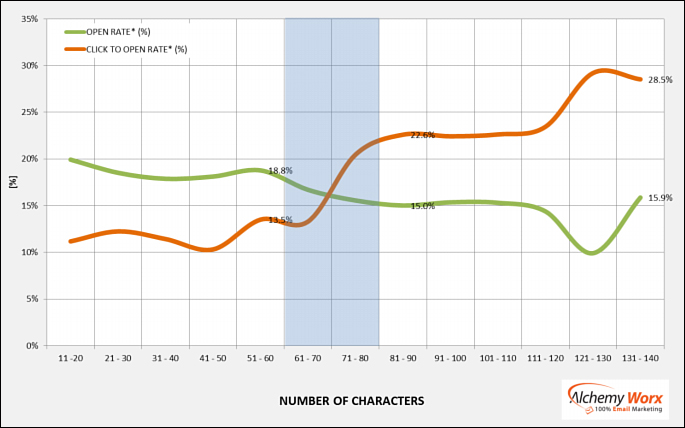9. My Word! You Must Read This Now!
Think of how excited you’d feel if you received an email from one of your favorite companies (Apple)—the Subject line announcing the newest iPhone, the one for which you’ve been waiting several months. Think of how likely you are to open an email from your favorite shoe store, the Subject line promising an impossible-to-say-no-to discount for that pair of cowboy boots you’ve been swooning over.
However, if you’re an Android fan, the Subject line of that iPhone email might not be all that interesting to you. What if you prefer tennis shoes to cowboy boots? Does the subject’s promise of a discount matter? Is there such a thing as the perfectly written email Subject line?
We don’t think so. It all depends on the subscriber. What is a perfect subject line to get you to open an email might not be for your co-worker sitting three feet from you in the next cubicle. The types of Subject lines that grab your attention might be the same ones that your significant other ignores, deletes, or marks as spam.
This chapter examines two email marketing best practices you’ve likely read about at some point, both involving the ideal Subject line:
• Never use ALL CAPS or the word free in the Subject line unless you want to end up having your email land in a spam folder.
• Subject lines should be between 30 and 50 characters to get the best results.
Email Subject Line Words to Avoid
Ready for a quiz? Guess how many search results will be returned by Googling the following phrase (without quotes):
email subject line words to avoid
What do you think? Thousands? Tens of thousands? Hundreds of thousands? Millions?
Now, put this book down for a minute, grab your computer, and see how close your guess was. If you guessed “in the millions” you were correct. In fact, when we did that search, it returned more than ten million results, as shown in Figure 9.1.
Figure 9.1. We got more than ten million Google search results for the phrase “email subject line words to avoid” (no quotes).
A ton of content is floating around online that has to do with words you should avoid using in email Subject lines. It seems that everyone has something to say about which words trigger spam filters.
Interesting, but who cares? It matters because many of those articles and blog posts about which words to avoid in an email are just flat-out wrong. In fact, if you click through on many of those search results a few words pop up over and over as words to never (ever) use in an email Subject line.
The ones we found in many of the “top words to avoid” lists include
• Free
• Never
• Limited time
• Anything that looks like you are YELLING (all caps)
• Deal
Take a look at your own inbox right now. (Yes, you’ll have to put this book down, but just for a second.) Search for emails that use any of the preceding words or phrases that many blog posts and articles say you should avoid. Are there any emails with free in the Subject line? How about never or deal? Do any Subject lines include one or more words in all caps?
The answer is likely a resounding YES!
If you subscribe to any business-to-consumer or brand emails that use email to sell, we’re pretty certain that you’ll see the word free in the Subject line, most likely followed by the word shipping, or the phrase limited time offer. If you have opted in for deal-of-the-day sites, you quite possibly have in your inbox some Subject lines with the word deal in them.
When DJ searched his inbox for the word free, the results (shown in Figure 9.2) showed many emails using that forbidden word. Most of those emails were from well-known companies and brands, and none of them were in his spam folder.
Figure 9.2. DJ’s inbox is full of emails with Subject lines that include “spammy” words (such as free).
You know the old saying, “Don’t believe everything you read (or hear)?” It also applies in the online world. If you were to believe what you read on the Internet, you would never use the word free, include ALL CAPS, or have punctuation in the Subject line because doing so would trigger spam filters. These rules were true—more than five years ago.
Karen Rubin wrote the following about email spam trigger words in a January 2012 blog post:1
“One of the easiest ways to avoid SPAM filters is by carefully choosing the words you use in your email’s subject line. Trigger words are known to cause problems and increase the chances of your email getting caught in a SPAM trap. By avoiding these words in your email subject lines, you can dramatically increase your chances of getting beyond SPAM filters.”
Although it’s true some of these words might “increase the chances of your email getting caught in a SPAM trap,” it’s less likely than the article makes it sound. Chad White, Research Director at Responsys and author of The Retail Email Blog left a comment on Rubin’s blog post: “Content filtering hasn’t been a big component of spam filtering algorithms for nearly a decade. Sender reputation and, increasingly, engagement metrics are way more important. Any marketer with half-decent permission and list management practices will be able to use these words and phrases without worry.”
According to Laura Atkins, founding partner of the anti-spam consultancy and software firm Word to the Wise, the truth likely lies somewhere between those two extremes:
“Naïve content filtering (filtering on ‘FREE!!’ in the subject line2) hasn’t been a big component for nearly a decade, but content filtering...a much more complex and subtle style of content filtering, one that looks at the words in the subject lines and how they relate to the words in the body...is where filtering is going,” she wrote on her blog in response to Rubin’s post and White’s comments. “Content matters, don’t think it doesn’t. But don’t let word lists like the above frighten you off from crafting good subject lines.”3
Take a look at your spam folder now, but not those emails you proactively mark as spam. Instead, look at the emails that are automatically filtered as spam. (Note: Depending on which email client you are using—Gmail, AOL, Hotmail, Outlook, Yahoo!, and so on—they’ll either be in a “spam” or “junk” folder.) What do those Subject lines look like?
As you can see in Figure 9.3, which shows a screenshot of DJ’s Gmail spam folder, the spammy Subject lines include
• Mentions of the drugs Viagra and Cialis
• The phrase Investment inquiry
• Two Subject lines in a language other than English
• Re:UPSNotification Package_delivery-failure 06...
Figure 9.3. DJ’s Gmail spam folder shows what spammy Subject lines really look like.
Note the sender or From names on those emails. As you can see, the vast majority do not come from individuals or companies. Instead, they are from “Delivery-Confirmation” or “NOW 20% OFF” or “6090993_United Parcel-Se.”
Those are spam.
Now let’s take a look at some of the companies and individuals who break the rules and include words such as free or who craft emails with ALL CAPS in the Subject line—all with incredibly positive results.
King Arthur Flour: Achieving Higher Sales Using All Caps and FREE
Founded in Boston in 1790, King Arthur Flour (KAF), kingarthurflour.com, is not only the oldest flour company in the United States, it’s one of the country’s longest-standing companies, period. When it started more than 220 years ago, its main (and only) product was flour. Today, it sells top-quality baking products and serves as a baking resource through its blog and social media properties on Facebook and Twitter. Email marketing is an integral part of its online business and a main driver of sales, too.
In 2012, on February 29—a date that only comes around every four years—it decided to have some fun with the number 29. KAF sent an email to its list of more than 600,000 subscribers with the following Subject line:
29¢ shipping TODAY ONLY
As you can see in Figure 9.4, the incentive was “29¢ shipping on your order of $29+.” The offer, of course, ended on February 29 at midnight. Did you happen to notice anything “rule-breaking” about the Subject line?
Figure 9.4. An email sent by KAF on February 29, 2012 has the Subject line, “29¢ shipping TODAY ONLY.”
It used ALL CAPS! The next question you have (we think) is, “Yeah. Great. But did it work?” According to Halley Silver, Director of Online Services at KAF, this email resulted in the top sales day at KAF ever. EVER! KAF tends to break a lot of rules in regard to email marketing. What’s unique about it, however, is it doesn’t just break the rules for the sake of breaking the rules. Instead, the company is voracious about testing.
“We do tests all the time—two to three per month. Sometimes subject line, sometimes creative,” Silver said.
As you dive more into the “Breaking the Rules” part of this book, you’ll notice that the word testing appears more and more. This is not by accident. Like any effective marketer, testing is usually a critical component of a successful campaign. Sure, sometimes you’ll get lucky. Sometimes you’ll try something and it will just work. However, as you’ll see over the next several chapters, most successful marketers performed some type of test to determine what worked best for their audience. Remember: Best practices are practices that are best for your subscribers.
Back to KAF and its 600,000 person email list. With its list that large and that accounts for a large portion of the company’s digital marketing revenue, KAF takes email marketing pretty darn seriously.
“It’s incredibly powerful,” Silver told us. “Our email program is a top driver of traffic and the number one driver of revenue to our site.”
See—we told you that email marketing was not dead. In fact, KAF might be to “blame” for that $40.56 ROI of email discussed in the Introduction. If we had to bet, its ROI is quite a bit higher than the average.
KAF sends an email to its list two to three times per week, a number that jumps up during the holiday season. In addition to its full-list mailing, KAF also sends a monthly email to its retail and wholesale list. Finally, it sends a “please rate/review your recent product purchase” email once per week.
In 2011, it decided to test the email shown in Figure 9.5.
Figure 9.5. KAF split this 2011 email and sent to different portions of its list, each receiving a unique subject line.
The entire email shown in Figure 9.5—the preheader, header, copy, creative, and call to action—were identical for both test groups. The only part of the email that was different was the Subject line:
• Subject Line A: Ends Thursday: FREE SHIPPING
• Subject Line B: Hawaiian Pizza—the secret’s in the crust...
Notice that Subject line A, mentioning free shipping ending Thursday, is only reiterated in the head of the actual email. Compare that to Subject line B, about the Hawaiian pizza, for which there is a picture (looks good, right?) as well as a short note about it. The email copy and creative is much more an extension of Subject line B than it is of A. Finally, most would agree that Subject line B is more interesting. It almost leads the subscriber into the email—entices them to open it—to find out more about this pizza and the “secret” of the crust.
If you had to describe Subject line A, you might use adjectives such as boring or non-descriptive. Don’t worry; you’re not alone. We agree. Looking at Subject line A, it’s nearly impossible to tell what the contents of the email will include—other than the fact that the “free shipping” deal ends on Thursday.
Which Subject line do you think was the winner—garnering the most opens, clicks, and conversions?
If you guessed A, you are correct. However, if you guessed B, you are also correct. How is that possible? They both are winners?
It depends, of course, on what the winning criteria are for your Subject line test. Check out the results in Table 9.1.
Table 9.1. King Arthur Flour Subject Line Test Results

As you can see, although email B—the one with the more creative, enticing, descriptive Subject line—had a higher open rate (31.8 percent versus 27.2 percent), the sales for the email with the “boring” Subject line had sales that were nearly 400 percent higher. Better yet, the winning Subject line, according to sales numbers, was the one that broke two email marketing rules in one shot! That Subject line not only used the word FREE but also had it in all caps.
If you were running the email marketing at your organization, which result would you rather have? Assuming part of your compensation was tied to revenue, clearly the answer is A.
“As my colleague put it, customers open an email with a plan,” Silver shared. “Based on the subject line, the user goes in with an intent.” In this case, their intent was to take advantage of the free shipping. By including FREE SHIPPING in all caps, the Subject line stood out in subscribers’ inboxes. Note that KAF has worked extremely hard over the years to earn the trust of its customers. This trust likely contributed to the high open and conversion rates as well. The “sales” type of emails can also have a long-term effect. Have you ever saved an email from an individual or company to use later when you needed it? We have. So have our wives and our friends.
One of the strategies KAF employs to ensure its subscribers save their emails is to include recipes in every single one of its emails. “It’s very intentional that every one of our emails has a recipe in it,” Silver said. “People save them for the recipes.”
Tumbleweed: More Opens and Click-Throughs Using All Caps and Free
Tumbleweed Tiny House Company (tumbleweedhouses.com), a company founded by Jay Shafer, builds tiny houses, some less than 100 square feet. Tumbleweed tests its Subject lines often using a test feature in its email service provider’s software. This feature allows the company to easily test one Subject line against another to determine which has a higher open rate.
In one test,4 it pitted the following Subject lines against each other:
• Subject line A: It’s FREE. All the tiny houses on our site and more
• Subject line B: It features all the houses on our website plus more...
Not only did Subject line A (with the word FREE in all caps) win, it won by a large margin—26 percent more opens compared to Subject line B. Crystal Gouldey, an Education Marketing Associate at Aweber (Tumbleweed’s email service provider), believes that “People love free things, so using the word ‘free’ right up front may have been key here. Other than that, the subjects are very similar. Just one word can cause a huge difference.”
In another test Tumbleweed used the exact same Subject line in each version; however, version A was all caps:
• Subject line A: SOLAR LIVING GOES TINY
• Subject line B: Solar Living Goes Tiny
The criteria for the winning Subject line were opens as well as click-throughs. While many business to consumer (B2C) companies, such as KAF, measure success by the number of conversions (sales, registrations, and so on), this is not always the case. Tumbleweed was more interested in sharing its story and spreading its message.
We know what you are thinking: There is no way in the world version A—the ALL CAPS one—even came close in a head-to-head Subject line test. It’s not like Tumbleweed just used one “all caps” word in its Subject line. Instead, it capitalized every single word, as seen in Table 9.2.
See for yourself.
Table 9.2. Tumbleweed Subject Line Test Results

Version A received nearly 14 percent more opens and 30 percent more clicks than version B.5
Did these results surprise you? We’re guessing your first reaction to version A was something along the lines of “ALL CAPS! THAT’S SPAM!” You might have even yelled that very phrase at the top of your lungs. But here’s the thing: Tumbleweed tested it. It intentionally broke the rules and found success. It performed a similar test comparing “Amazing New Photos” to “AMAZING NEW PHOTOS.” Once again, the all-caps Subject line was the clear winner: 21 percent more opens and 31 percent more clicks than the other Subject line! Clearly, the Tumbleweed audience responds better to an all-caps Subject line.
Keep in mind that using all caps in your emails might not work for your audience, but now you have seen examples of case studies where it has worked for others. Whether you follow or break the rules depends on your audience. The only way you can know if they like or dislike all caps in their email Subject lines is to test.
The Proper Length of a Subject Line
Pinpointing exactly when the best practice of using a short subject line was first introduced is difficult, but it’s one that seems to live on (and on, and on). Somewhere, sometime, someone stated: “Email subject lines should be short.”
Dela Quist, CEO of Alchemy Worx (alchemyworx.com) suggests this advice originally came from email clients such as AOL who “truncated the subject line at 40 characters.”6
That theory seems quite logical and very possible, but where the original source of this advice came from is still unclear. Either way, it’s one of those best practices that has prevailed over the years. In a 2007 report, MailerMailer, an email marketing service, came right out and said, “Always use short, descriptive subject lines.”7
In a 2008 blog post, email service provider MailChimp concluded that, “Shorter subject lines seemed to work better than long subject lines (the difference in open rate was more noticeable when they differed by 30 characters).”8
To be fair to both MailerMailer and MailChimp, these quotes are from 2007 and 2008, respectively. But this is the Internet. Four or five years is an eternity and, yes, times have changed. In June of 2011, MailChimp stated, “The general rule of thumb in email marketing is to keep your subject line to 50 characters or less. Our analysis found this to generally be the rule. The exception was for highly targeted audiences, where the reader apparently appreciated the additional information in the subject line”9 (emphasis is ours).
Others in the industry simply believe that the optimal subject line depends. “We have clients [who use] short and to-the-point subject lines (think VIP invitations with clear and concise benefits/calls to action) and others where lengthy subject lines tease you into reading the email and acting,”10 said Simms Jenkins, author of The Truth About Email Marketing and CEO of BrightWave Marketing.
Data and metrics aside, one of the reasons many email marketing folks argue that “shorter is better” in regard to email Subject line length is because of readability.
The problem with longer Subject lines is they often get truncated in many email clients, as shown in Figure 9.6.
Figure 9.6. This Subject line from HuffPost Media was cut off due to its length.
As you can see in this very long (93 character) Subject line from HuffPost Media in Figure 9.6, the last few characters are cut off. The Subject line ends with “Buchanan V...” Is that the first initial of Buchanan’s last name or is it the start of a new word? Although it’s not necessarily problematic, depending on where your Subject line gets truncated, it could make a difference in context.
As you can see in the following example, when cut off at 26 characters, the entire meaning of this Subject line is lost. As Mark Brownlow said, “...sometimes, frankly, you just have to smile.”11
Full Subject line: Get up to 70% off children’s fashion
Subject line truncated at 26 characters: Get up to 70% off children
Character length on smartphones can be even more pronounced. Take the iPhone, for example. Depending on your individual settings, the average Subject line can max out at 35 characters, as you can see in Figure 9.7.
Figure 9.7. The Subject line of this Nike email got cut off on an iPhone after 35 characters.
In addition to lost meaning, another argument against long Subject lines is that, in the age of social media, brevity rules. SMS (Short Message Service or simply “text messaging”) is limited to 160 characters, whereas Twitter has a 140-character limit. Many of us seem to have a short attention span. Assuming that applies to email marketing, shorter likely is better.
However, as we’ve stated before, it depends on what metric is most important to you. According to Mark Brownlow, it’s actually quite easy to write Subject lines for high open rates: “Segment by gender and send this [subject line] to your male subscribers: Free beer as a thank you for subscribing.”12 However, if you want click-throughs, be sure the email copy contains a simple way to redeem that free beer.
In all seriousness, if your goal is more opens, using a short, catchier Subject line might be better. If you are trying to get your subscribers to take some kind of action (click-through or convert), using a more direct, possibly longer Subject line might be the answer.
Or maybe it’s just the opposite. Again, it depends on your audience.
Measuring Success
Too often, marketers measure the wrong things or don’t measure anything at all. Always keep the goal of each and every email you send in mind. Is success determined by open rate? Click-throughs? Clicks-to-opens (the number of clicks divided by number of opens)? Conversions/sales?
Consider the following scenario: You’ve been reading this book that keeps suggesting to test all aspects of your email campaigns to determine what works best for your audience. You decide to do a test based on Subject line: 50 percent get Subject line A; 50 percent get Subject line B. Group A gets an email with a short, direct, to-the-point Subject line. Group B receives one with a Subject line that’s so long it gets cut off in most email clients.
Forty-eight hours after both emails are sent, you observe the following statistics:
• Subject line A: 20 percent open rate
• Subject line B: 10 percent open rate
Which Subject line is the winner? A (the shorter one) or B (the crazy long one)? Based on open rate alone, you would be silly (or not that great with numbers) unless you said “A” was the winner: 20 percent versus 10 percent. Group A’s open rate was twice that of Group B’s.
However, now consider the following metrics:
• Subject line A: 500 clicks
• Subject line B: 1,000 clicks
Using the same logic as earlier, Group B is the clear winner.
Now, taking the example one step further, let’s look at conversions (sales):
• Subject line A: $10,000 in email-related sales
• Subject line B: $20,000 in email-related sales
Looks like “B” wins again.
The bottom line is this: Depending on the goal of your email campaign, a different (possibly longer) Subject line might outperform another (shorter).
But that’s just a made-up scenario. How about a test using real client data?
Evidence in Favor of Long Subject Lines
Although many people have thought the short Subject line is the rule for several years now, many studies have been published to contradict that mentality. Instead, as discussed in this section, a longer Subject line might be the answer to more clicks and increased sales.
Alchemy Worx is the United Kingdom’s largest full-service email marketing agency. It helps clients with everything from copywriting to design to testing and provides delivery and deployment services as well as reporting and analysis consulting. Its clients work with a full range of email service providers. This means, as an agency, it is ESP-agnostic (in other words, they do not favor one ESP over another). This helps when sharing testing results because it displays no bias towards one provider.
In a 2008 study,13 Alchemy Worx ran a test similar to the earlier fictional scenarios; however, it used actual client data. Alchemy Worx analyzed 646 Subject lines across 205 million messages sent over nearly five years. Its conclusions were interesting. The first was that the longer the Subject line, the lower the open rate. As you can see in the chart in Figure 9.8, an inverse relationship exists between open rates and Subject line length (determined by number of characters).
Figure 9.8. An Alchemy Worx study shows the inverse relationship between open rates and the number of characters in the Subject line.
All of those in favor of email marketing best practices just rejoiced with a big, resounding, “See. We told you!”
However, that’s only the first part of the study results from Alchemy Worx. The agency also discovered the longer the Subject line, the higher the click-to-open rates. But that’s not all: The click-through rate (clicks divided by delivered) also increases. In other words, you get more clicks with fewer opens!
Dela Quist, CEO of Alchemy Worx, believes that the key to Subject lines is meaning. “The shorter the subject line, the less likely you are to convey meaning. People have to open your email [to understand what it means].”
An example of a company who is notorious for sending emails with creative (and short) Subject lines is Urban Outfitters (urbanoutfitters.com). It intentionally writes its Subject lines to entice its audience to open the email to uncover the content. The following are a few actual Subject lines from Urban Outfitters:
• Top This
• A Dress For...
• Color It In
• 5, 4, 3, 2, 1...
• Introducing...
Consistent with what Quist said, conveying meaning with Subject lines that short is hard. They certainly tend to pique interest, thus leading to an open. However, as evidenced by the Alchemy Worx study, a higher open rate does not necessarily mean a higher click rate.
On the complete other end of the spectrum from Urban Outfitters is Groupon. Although certainly not always the case, some of its Subject lines tend to be on the long to very long side. In a February 16, 2012 email DJ received, the Subject line read:
One Oil Change, Three Oil Changes with Inspections, or a Four-Wheel Alignment (Up to 78% Off) | 10 or 20 Gym Passes (Up to 69% Off) | Salon Package with Cut, Style, and Two-Color Highlights; Shellac Manicure; or Acrylic Nails (Up to 51% Off)
Coming in at a whopping 42 words and 241 characters, this Subject line is in the very, very, VERY long category, possibly the longest we’ve ever seen. As you can imagine, it was truncated in Gmail to “ One Oil Change, Three Oil Changes with Inspections, or a Four-Wheel Alignment (Up to 78....”
“With a longer subject line, the person can decide if the email is relevant. Although fewer emails are opened, those who open them are more qualified,” said Quist.14
While we agree with Quist on this point, this Groupon Subject line might actually be too long to determine relevance. If you were in need of a car-related service, you would be more likely to open and click through on this email. However, if this email landed in your inbox and you were interested in gym passes or a salon package, due to the super-long nature of this Subject line, you would never know they were also being offered.
The Alchemy Worx study also found similar relationships when looking at number of words rather than number of characters. Subject lines with more words had a higher click to open rate compared to those with fewer words. It concluded this was true because words often are more important when conveying concepts compared to characters.
Alchemy Worx suggests that if you want to maximize open rates, using ambiguous (like Urban Outffiters does) or somewhat misleading Subject lines, which are often the shorter ones, is best. However, you have to be careful with deceptive Subject lines because they are illegal under the CAN-SPAM Act (it’s what spammers do!).
To summarize, the Alchemy Worx study came to the following three conclusions:
• Shorter Subject lines generate higher open rates, a measure of reader interest, but much lower click-to-open rates.
• Longer Subject lines earn a much higher click-to-open rate, an indication of real relevance.
• The open rate and click-to-open rate curves intersect at about 60 to 70 characters, a “dead zone” where neither metric is optimized.
To muddy the waters a bit, studies have also shown longer Subject lines lead to higher open rates, among other things.
One of our favorite websites in regard to performing split tests is WhichTestWon. com. Founded by Anne Holland in 2009, WhichTestWon.com has more than 150 test case studies ranging from web to email to direct mail. It adds a new test every week and allows readers to vote on which option (A or B) they think is the winner.
In its 2011 “Long vs. Short Email Subject Line Test,”15 WhichTestWon.com asked its members to guess which email received more opens and webinar registrations in a test for Sonic Foundry. The company sent an email targeting information technology and audio-visual decision makers. The split test featured only the Subject line as the differentiator. Everything else was the same.
• Subject line A: January 25 webinar: Enterprise Webcasting for High-Profile Clients
• Subject line B: January 25 webinar: Webcasting High-Profile Clients
Subject Line A was eight words and 66 characters long whereas its counterpart (B) was only six words and 51 characters. Any guesses which Subject line led to more opens, more click-throughs, and more webinar registrations? Humor us and forget for a minute that you’re reading a book about breaking the rules of email marketing. If you guessed Subject line B, you would be in the majority, along with 63 percent of the site visitors on WhichTestWon.com who voted. Only 37 percent guessed that Subject line A was the winner.
However, even if you guessed A was the winner, we think you’ll be surprised by how much it won by. Compared to Subject line B, A’s open rate was 58.9 percent higher, its click-through rate was 224 percent more, and—most importantly for Sonic Foundry—webinar registrations jumped by 279 percent.
To be fair, a test like this is not as black and white as it might seem. Although it would appear that Subject line A won because it was longer, this might not be the case. After all, as the team at Sonic Foundry noted, the inclusion of the word Enterprise in Subject line A possibly was the reason for the higher numbers. Subject lines are something Sonic Foundry now tests on every webinar invite it sends.
The Most Incredible Chapter Ever
So this probably wasn’t the most incredible chapter you’ve ever read. But it was vitally important in understanding how to approach email marketing like a rebel. Just because the madding crowd is running off the cliff with their aversion to ALL CAPS and propensity for short Subject lines doesn’t mean you have to join them. What you’re learning is that ALL CAPS and using certain spam trigger words, such as free and limited time and deal, are only a bad idea after you’ve tested Subject lines containing them with your audience and gotten bad results.
Even if you’ve proven through testing that they don’t work with your audience, you can still pull them out and have them prove effective. Try a random FREE SHIPPING email now and then and see whether you notice a jump in your success metrics, even if your tests show ALL CAPS are a turn off. If the current gold-standard case study for an email marketing success story, Groupon, can use a Subject line that is 42-words long, well, the shorter is better thing becomes null and void, too. Still, tossing out a short, teasing email Subject line will likely produce more opens or clicks, even when your tests show longer Subject lines are what the audience prefers.
In true rebel form, there are no rules—not even when you think there are. And that truth starts with Subject lines, but also applies to the design, or how your emails look.
Endnotes
1. Rubin, Karen, “The Ultimate List of Email SPAM Trigger Words.” January 11, 2012. http://blog.hubspot.com/blog/tabid/6307/bid/30684/The-Ultimate-List-of-Email-SPAM-Trigger-Words.aspx
2. Waldow, DJ, “Words to Avoid in a Subject Line.” March 7, 2012. http://waldowsocial.com/words-to-avoid-in-a-subject-line/ (update to blog post based on Laura Atkins email)
3. Atkins, Laura, “Content, trigger words and subject lines.” January 11, 2012. http://blog.wordtothewise.com/2012/01/content-trigger-words-and-subject-lines/
4. “Why Should You Split Test Email Subject Lines?” http://www.aweber.com/blog/email-marketing/why-should-you-split-test-email-subject-lines.htm
5. WhichTestWon, “Email Subject Line Test: ALL CAPS vs Initial Caps.” http://whichtestwon.com/email-subject-line-test-initial-caps-vs-all-caps
6. Alchemy Worxs Whitepaper, “Subject lines —length is everything.” 2008. http://www.alchemyworx.com/Alchemy%20Worx%20Subject%20lines%20-%20length%20is%20everything.pdf
7. MailerMailer, “Email Marketing Metrics Report. JANUARY–JUNE (H1) 2007. http://cdn.mailermailer.com/documents/email-marketing-metrics-2007h1.pdf
8. MailChimp blog post, “A/B Split Testing —Does it Help Email Marketing?” August 28, 2008. http://blog.mailchimp.com/ab-split-testing-does-it-help-email-marketing/
9. MailChimp support article, “Best Practices in Writing Email Subject Lines.” Updated June 22, 2011. http://kb.mailchimp.com/article/best-practices-in-writing-email-subject-lines
10. Jenkins, Simms, “4 Surefire Ways to Get Your Emails Read.” August 25, 2011. http://www.clickz.com/clickz/column/2103830/surefire-emails-read
11. Brownlow, Mark, “Truncation traps: 3 more subject line lessons.” June 4, 2010. http://www.email-marketing-reports.com/iland/2010/06/truncation-traps-3-more-subject-line-lessons.html
12. Brownlow, Mark, “5 lessons from a typical subject line test.” August 26, 2011. http://www.email-marketing-reports.com/iland/2011/08/subject-line-test.html
13. Alchemy Worx Whitepaper, “Subject lines —length is everything.” 2008. http://www.alchemyworx.com/Alchemy%20Worx%20Subject%20lines%20-%20length%20is%20everything.pdf
14. McDonald, Loren, “Guest Q&A: Dela Quist on Managing Inactives, Subject Line Length and Marketers’ Fear & Self-Loathing.” January 20, 2012. http://www.silverpop.com/blogs/email-marketing/dela-quist-subject-line-length.html
15. WhichTestWon.com, “Long vs Short Email Subject Line Test.” February 9, 2012. https://whichtestwon.com/long-vs-short-email-subject-line-test
